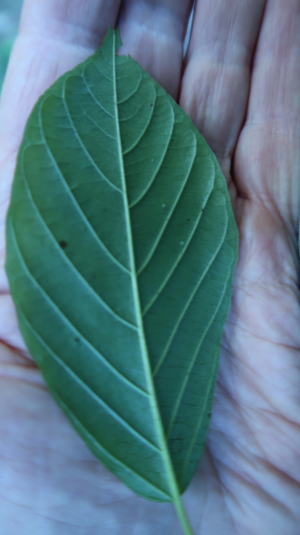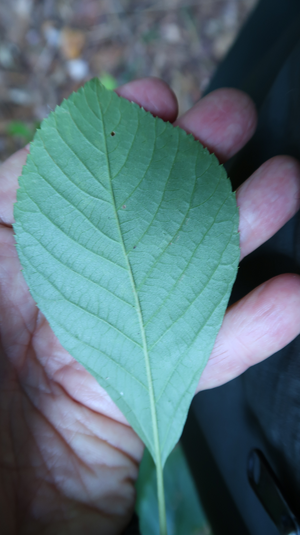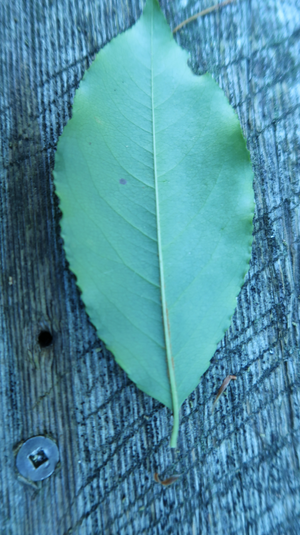Glossy Buckthorn: Difference between revisions
Watlington (talk | contribs) m (Fixed CISMA link) |
Watlington (talk | contribs) (Harmonized the style with other entries) |
||
| (3 intermediate revisions by one other user not shown) | |||
| Line 1: | Line 1: | ||
[https://cisma-suasco.org/invasive/glossy-buckthorn/ | '''Frangula alnus''' ''a.k.a.'' '''Rhamus frangula''' ( [https://cisma-suasco.org/invasive/glossy-buckthorn/ CISMA], [http://plants.usda.gov/core/profile?symbol=FRAL4 USDA], [http://en.wikipedia.org/wiki/Rhamnus_frangula Wikipedia], [https://gobotany.nativeplanttrust.org/species/frangula/alnus/ GoBotany], [https://www.invasiveplantatlas.org/subject.html?sub=5649 IPANE] ) | ||
[[File:Frangula alnus - wetland 2.jpg|alt=Glossy Buckthorn, with berries|left|thumb]] | [[File:Frangula alnus - wetland 2.jpg|alt=Glossy Buckthorn, with berries|left|thumb]] | ||
[[File:Rhamnus frangula 05 ies.jpg|alt=Glossy Buckthorn stem, with berries|right|thumb]] | |||
Glossy Buckthorn, a small tree or coarse shrub that grows up to 20 ft. tall, is one of the most common invasive plants in Acton. Its simple leaves leaves are 1 - 2.5 in. long, have untoothed edges and are usually arranged alternately although they may appear almost opposite near the branch tips. The leaves are dark green (in the summer) and glossy above, with either no hairs or slight hairs beneath. The leaves turn greenish-yellow to yellow late in the fall, and remain on the plant when most other species have already lost their leaves. | Glossy Buckthorn, a small tree or coarse shrub that grows up to 20 ft. tall, is one of the most common invasive plants in Acton. Its simple leaves leaves are 1 - 2.5 in. long, have untoothed edges and are usually arranged alternately although they may appear almost opposite near the branch tips. The leaves are dark green (in the summer) and glossy above, with either no hairs or slight hairs beneath. The leaves turn greenish-yellow to yellow late in the fall, and remain on the plant when most other species have already lost their leaves. | ||
| Line 8: | Line 8: | ||
It flowers with clusters of one to eight 5-petaled yellow-green flowers after the leaves expand, from May to August. The berries are round and roughly 0.25 in diameter. They change from red to black as they ripen, from July to August. It should be noted that at any given time there can be flowers, partially ripened fruits (red) and fully ripened fruits (black) present on the same plant. | It flowers with clusters of one to eight 5-petaled yellow-green flowers after the leaves expand, from May to August. The berries are round and roughly 0.25 in diameter. They change from red to black as they ripen, from July to August. It should be noted that at any given time there can be flowers, partially ripened fruits (red) and fully ripened fruits (black) present on the same plant. | ||
[[File: | |||
== Removal == | |||
Smaller Glossy Buckthorn saplings (up to around 1/2 inch in diameter) can be pulled. If larger saplings are pulled, the roots will break off and regrow (producing a ring of saplings in a year). | |||
It is better to kill the root system of larger plants. For large trees (larger than 1 inch diameter), [[girding]] is recommended. | |||
Intermediate sized plants may be killed by repeated cutting. This should NOT be done at ground level, or many shoots (a hydra!) will result. It is better to cut it about four feet up. The plant will concentrate its growth at the top of the cut stems instead of producing new shoots. On subsequent visits, the stem may be shortened to remove the new growth, eventually killing the plant. | |||
There are other approaches: | |||
* Using a cable tie to securely fasten a thick black plastic bag over a stem cut short. It is hard to prevent regrowth from the base of the stem. Otherwise, this works, but you have to go back and retrieve the bags/ties. | |||
* Nailing a large can over a stem cut short. Here the can can be pressed into the ground to prevent regrowth from the base of the stem. Again, the can has to be removed afterwards (and you need lots of them). | |||
== Common Mis-identifications == | |||
=== Identification by Leaf === | |||
Two plants that can be mistaken for buckthorn are sweet-pepperbush and winterberry. The best way to discriminate is to look at the underside of the leaves: | |||
[[File:Buckthorn-leaf.png|alt=Buckthorn Leaf|left|thumb|Buckthorn]] | |||
[[File:Sweet-pepperbush-leaf.png|alt=Sweet Pepperbush Leaf|thumb|none|Sweet Pepperbush]] | |||
<br clear='all'> | |||
Buckthorn and Sweet Pepperbush have well defined veins that curve toward the leaf tip (mature buckthorn has 8-9 veins). But Sweet Pepperbush leaves have teeth and buckthorn leaves do not. | |||
[[File:Winterberry-leaf.png|alt=Winterberry Leaf|thumb|left|Winterberry]] | |||
Winterberry leaves do NOT have 8-9 well defined veins, and have teeth as well. For small plants, buckthorn and low bush blueberry can sometimes be confused when viewed from above, but the underside of low bush blueberry leaves do not have well defined veins. Generally, plants that might be confused with buckthorn, other than sweet pepperbush, do not have well defined veins when the underside of the leaf is viewed. | |||
<br clear='all'> | |||
=== Identification by Bark === | |||
TBD | |||
=== Identification by Buds In Winter === | |||
TBD | |||
=== Identification by Twigs === | |||
TBD | |||
Latest revision as of 22:58, 16 January 2024
Frangula alnus a.k.a. Rhamus frangula ( CISMA, USDA, Wikipedia, GoBotany, IPANE )


Glossy Buckthorn, a small tree or coarse shrub that grows up to 20 ft. tall, is one of the most common invasive plants in Acton. Its simple leaves leaves are 1 - 2.5 in. long, have untoothed edges and are usually arranged alternately although they may appear almost opposite near the branch tips. The leaves are dark green (in the summer) and glossy above, with either no hairs or slight hairs beneath. The leaves turn greenish-yellow to yellow late in the fall, and remain on the plant when most other species have already lost their leaves.
Young stems are greenish, often with soft fine hairs. Older bark is grayish-brown, with prominent light raised lenticels. Despite the name, it has no thorns. The heartwood (visible when cut) is pinkish to orange in growth over a couple of years old. The roots are deep red.
It flowers with clusters of one to eight 5-petaled yellow-green flowers after the leaves expand, from May to August. The berries are round and roughly 0.25 in diameter. They change from red to black as they ripen, from July to August. It should be noted that at any given time there can be flowers, partially ripened fruits (red) and fully ripened fruits (black) present on the same plant.
Removal
Smaller Glossy Buckthorn saplings (up to around 1/2 inch in diameter) can be pulled. If larger saplings are pulled, the roots will break off and regrow (producing a ring of saplings in a year).
It is better to kill the root system of larger plants. For large trees (larger than 1 inch diameter), girding is recommended.
Intermediate sized plants may be killed by repeated cutting. This should NOT be done at ground level, or many shoots (a hydra!) will result. It is better to cut it about four feet up. The plant will concentrate its growth at the top of the cut stems instead of producing new shoots. On subsequent visits, the stem may be shortened to remove the new growth, eventually killing the plant.
There are other approaches:
- Using a cable tie to securely fasten a thick black plastic bag over a stem cut short. It is hard to prevent regrowth from the base of the stem. Otherwise, this works, but you have to go back and retrieve the bags/ties.
- Nailing a large can over a stem cut short. Here the can can be pressed into the ground to prevent regrowth from the base of the stem. Again, the can has to be removed afterwards (and you need lots of them).
Common Mis-identifications
Identification by Leaf
Two plants that can be mistaken for buckthorn are sweet-pepperbush and winterberry. The best way to discriminate is to look at the underside of the leaves:


Buckthorn and Sweet Pepperbush have well defined veins that curve toward the leaf tip (mature buckthorn has 8-9 veins). But Sweet Pepperbush leaves have teeth and buckthorn leaves do not.

Winterberry leaves do NOT have 8-9 well defined veins, and have teeth as well. For small plants, buckthorn and low bush blueberry can sometimes be confused when viewed from above, but the underside of low bush blueberry leaves do not have well defined veins. Generally, plants that might be confused with buckthorn, other than sweet pepperbush, do not have well defined veins when the underside of the leaf is viewed.
Identification by Bark
TBD
Identification by Buds In Winter
TBD
Identification by Twigs
TBD